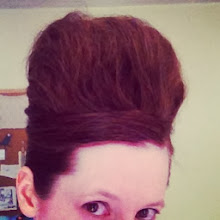I keep trying to tell you about gumbles, but I am stymied. I don't have a good picture, and the pictures are so important, their little big-nosed faces and square tuftiness, like when I was small and had those cotton sleeping bags which were rectangles with a hood and I put my feet and hands in the corners and walked around. Line drawings, which was also important; perfect, effortless economy of expression, tricks and emotions and the kernel of the action, the very smell of a place captured in a flash, pen and ink at a guess, but I didn't know any of this.
I don't have the books any more. I haven't read them since I was small. I should read them again but I want to tell you about them before BigXtin eyes make me forget how TinyXtin felt about them. I'm stymied because they matter so much and I have no idea how to make that seem true. I am frightened that I will write about them and nothing that I say will draw the right lines around the reasons.
Gumbles live in the Australian bush, in a little gumble ensemble. Fixingumble fixes things and builds things and Happigumble is a worrier and Willigumble is the take-no-prisoners tiniest gumble and Tinkingumble has ideas. When he has an idea, he goes <tink>. The other gumbles call his ideas 'tinks', for no gumble would bother with a distinction between the thought and the sound it makes.
Tinkingumble was my favourite, of course. He hatches wild plots and gets the gumbles out of scrapes with his gumblebrain and my delight at an audible manifestation of a thought never grew old. And of course, by perfect gumble logic, the tink got louder the better the idea. There's one story where the gumbles are hiding and desperately egging Tinkingumble on to mastermind their escape and Tinkingumble's tinks both risk their exposure and save the day. Because of course they do. Ideas are dangerous.
The gumble-nemeses were the bottersnikes: scaly bunyippy things with draggle-ended tails. They'd trap the gumbles and squash them into jam tins, because if you squash a gumble very hard he cannot unsquash himself. Bottersnikes eat old mattress stuffing. When they get angry, their ears glow red-hot at the tips, and they can start fires.
There was very little Australia in the books on TinyXtin's shelf. Mostly an imagined Australia, especially in the interwar colonial classics Snugglepot & Cuddlepie and Blinky Bill, talking koalas and goannas and seahorses like animated natural history illustrations, japes and pranks and dances and frogs having diving competitions and peach-cheeked blue-eyed bush fairies trying on tiny eucalyptus leaves in tiny fairy dress shops, as far from a sense of real place as one might hope to dream up, neatly garnished with a few sentimental morals about Humans being kind to Bush creatures.
The gumbles are imagined, but not so much their Australian bush. Hot and dusty, trees and lakes. Eucalyptus and tea-tree, thorn bushes. Birds and animals that do bird and animal things. Abandoned mattresses, jam tins and bottle tops, burnt-out cars, corrugated iron. A jam tin is what a billy is made of, if you ever wondered. Sheep. Flies. Ants. And the casual threat of fire.
Not a big, dramatic, foreboding evil. Not being orphaned, or war, or the Dark Lord, or kidnapping or blackmail or murder or abandonment. Not these, but the everyday, throwaway, match-astray disaster of fire.
On Ash Wednesday 1983, when I was nearly ten, more than two thousand square kilometres of my home state Victoria was on fire. I opened the front door of our house that night and I could smell Mount Macedon burning 60 kilometres to the north-west. Soot was floating in the air. Eucalyptus barbeque. On the news people were standing on their roofs hosing down their houses, praying no ill-blown spark would catch against their veranda. Later my brother and I would give all our Lego to the children who had lost everything. TODAY IS A DAY OF TOTAL FIRE BAN, sang all the summers of my childhood. Public service advertisements, people clearing everything not rooted to the ground in twenty-meter fire-protection zones around their houses.
Bottersnikes shrink if you get water on them. You have to hang them out to dry.



No comments:
Post a Comment